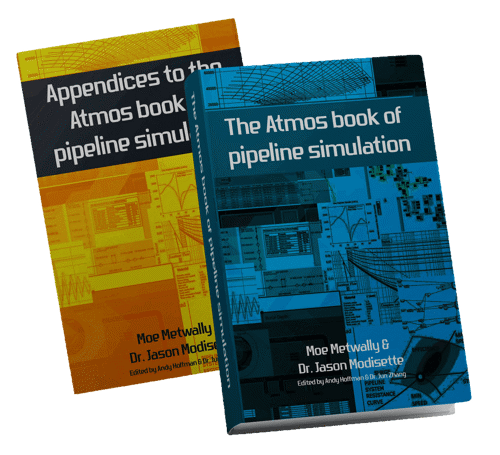Pertinent discussions of interest to pipeline simulation professionals
Written by expert engineers from Atmos International (Atmos), “The Atmos book of pipeline simulation” was published this week. The book provides a unique and in-depth insight into pipeline simulation technology, with specific examples demonstrated using Atmos Simulation (SIM) Suite.
There are insights into the behavior of gas and liquid pipelines and the associated equipment. The book discusses how computers deal with challenging physical laws involving partial differential equations by solving them using special numerical methods, and how pipeline simulation software deals with challenging real-world pipeline data pragmatically.
Moemen Metwally, Application Support Engineer at Atmos and the main author of the book said:
“This book addresses a set of pertinent discussions of interest to pipeline simulation professionals. These have, to our knowledge, never been compiled before in a single convenient place. It aims to contextualize what pipeline simulation is all about.”
Jason Modisette, Chief Simulation Scientist and the co-author of the book said:
“The world is going to need pipeline simulation software for a long time to come. This is the book I wish I’d had when I started in the field, it covers how oil and gas pipelines work in practice with pipeline simulators.”
A unique and in-depth insight into pipeline simulation
A few of the standout features of the book include:
- The value of Atmos SIM being versatile, modeling gas and liquid pipelines and simulating every type of scenarios: offline, online, look-aheads and as a tool for training and assessment
- The importance of a transient ground thermal model to calculate the inventory and estimated time of arrival (ETA) when simulating many pipeline scenarios
- The thermodynamic principles and detailed calculations governing the performance of pumps, compressors and associated equipment, including their efficiency and energy consumption
- How the automated Atmos Tuning Assistant facilitates calibrating models manually, and how automatic learnt parameters act to keep a model well-calibrated while simulating in real-time
- How smart adaptive knot-spacing and time-stepping algorithms improve both the speed and the accuracy of a simulation
- Why the Maximum Likelihood State Estimator, using a statistical approach, is the most reliable method for reconciling potentially flawed meter data in real-time
- How advanced look-aheads, cloud computing and strategic optimizers empower pipeliners with insights they never had before, allowing them to perform intelligent pipeline operations
There are two core parts, one main book and an appendices, meaning readers can dive straight into the technical details. The appendices provide the history of pipelines, background information on the energy industry, a primer on pipeline essentials, a discussion around hydrogen and a quiz to consolidate knowledge.
Dr Jun Zhang, founder and CEO at Atmos said “The Atmos book of pipeline simulation provides an excellent in-depth overview of pipeline hydraulics. It demonstrates how using these future-proof solutions like Atmos SIM can help understand complex pipeline operations, provide critical information for pipeline control and safety management, improve efficiencies and maximize profits”.
A summary of the chapters
The main book covers an array of subjects over 13 chapters, with Atmos SIM applied to real life examples.
Chapter 1 - Model-building: what is a pipeline?
Chapter 2 - The simulation engine
Chapter 3 - A simulator’s performance
Chapter 4 - Shut-in pipelines: sitting still
Chapter 5 - Steady states: flowing forever
Chapter 6 - Temperature: the thermal model
Chapter 7 - Pumping and compression
Chapter 8 - Operations: change in motion
Chapter 9 - Rapid transients & surge analysis
Chapter 10 - Leaks and ruptures
Chapter 11 - Live on site
Chapter 12 - Look-aheads and optimizers
Chapter 13 - Beyond single phase
To get your copy of “The Atmos book of pipeline simulation”, visit here.
Learn more about Atmos SIM and how it helps to run pipelines safely and cost effectively at all times.

